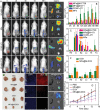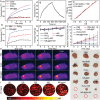Cytomembrane-Mediated Transport of Metal Ions with Biological Specificity
- PMID: 31508286
- PMCID: PMC6724363
- DOI: 10.1002/advs.201900835
Cytomembrane-Mediated Transport of Metal Ions with Biological Specificity
Abstract
Metal ions are of significant importance in biomedical science. This study reports a new concept of cytomembrane-mediated biospecific transport of metal ions without using any other materials. For the first time, cytomembranes are exploited for two-step conjugation with metal ions to provide hybrid nanomaterials. The innate biofunction of cell membranes renders the hybrids with superior advantages over common vehicles for metal ions, including excellent biocompatibility, low immunogenic risk, and particularly specific biotargeting functionality. As a proof-of-concept demonstration, cancer cell membranes are used for in vivo delivery of various metal ions, including ruthenium, europium, iron, and manganese, providing a series of tumor-targeted nanohybrids capable of photothermal therapy/imaging, magnetic resonance imaging, photoacoustic imaging, and fluorescence imaging with improved performances. In addition, the special structure of the cell membrane allows easy accommodation of small-molecular agents within the nanohybrids for effective chemotherapy. This study provides a new class of metal-ion-included nanomaterials with versatile biofunctions and offers a novel solution to address the important challenge in the field of in vivo targeted delivery of metal ions.
Keywords: bioimaging; biotargeted transport; cell membrane; metal ions; tumor therapy.
Conflict of interest statement
The authors declare no conflict of interest.
Figures





Similar articles
-
A Facile and Universal Method for Preparing Polyethylene Glycol-Metal Hybrid Nanoparticles and Their Application in Tumor Theranostics.Adv Healthc Mater. 2022 Jun;11(12):e2200044. doi: 10.1002/adhm.202200044. Epub 2022 Mar 4. Adv Healthc Mater. 2022. PMID: 35192244
-
Tumor Diagnosis and Therapy Mediated by Metal Phosphorus-Based Nanomaterials.Adv Mater. 2021 Dec;33(49):e2103936. doi: 10.1002/adma.202103936. Epub 2021 Oct 1. Adv Mater. 2021. PMID: 34596931 Review.
-
2D transition metal dichalcogenide nanosheets for photo/thermo-based tumor imaging and therapy.Nanoscale Horiz. 2018 Mar 1;3(2):74-89. doi: 10.1039/c7nh00158d. Epub 2017 Nov 8. Nanoscale Horiz. 2018. PMID: 32254070
-
Endoplasmic reticulum-targeted phototherapy using one-step synthesized trace metal-doped carbon-dominated nanoparticles: Laser-triggered nucleolar delivery and increased tumor accumulation.Acta Biomater. 2019 Apr 1;88:462-476. doi: 10.1016/j.actbio.2019.02.005. Epub 2019 Feb 5. Acta Biomater. 2019. PMID: 30735810
-
Inorganic nanomedicine--part 2.Nanomedicine. 2010 Oct;6(5):612-8. doi: 10.1016/j.nano.2010.04.003. Epub 2010 Apr 22. Nanomedicine. 2010. PMID: 20417314 Review.
Cited by
-
Homologous-adhering/targeting cell membrane- and cell-mediated delivery systems: a cancer-catch-cancer strategy in cancer therapy.Regen Biomater. 2024 Nov 21;12:rbae135. doi: 10.1093/rb/rbae135. eCollection 2025. Regen Biomater. 2024. PMID: 39811105 Free PMC article. Review.
-
Biomedical Implants with Charge-Transfer Monitoring and Regulating Abilities.Adv Sci (Weinh). 2021 Aug;8(16):e2004393. doi: 10.1002/advs.202004393. Epub 2021 Jun 24. Adv Sci (Weinh). 2021. PMID: 34166584 Free PMC article. Review.
-
Biomimetic nanomaterial-facilitated oxygen generation strategies for enhancing tumour treatment outcomes.Front Bioeng Biotechnol. 2022 Oct 5;10:1007960. doi: 10.3389/fbioe.2022.1007960. eCollection 2022. Front Bioeng Biotechnol. 2022. PMID: 36277398 Free PMC article. Review.
-
Tumor-Derived Membrane Vesicles: A Promising Tool for Personalized Immunotherapy.Pharmaceuticals (Basel). 2022 Jul 16;15(7):876. doi: 10.3390/ph15070876. Pharmaceuticals (Basel). 2022. PMID: 35890175 Free PMC article. Review.
-
Optimization of Metal-Based Nanoparticle Composite Formulations and Their Application in Wound Dressings.Int J Nanomedicine. 2025 Mar 6;20:2813-2846. doi: 10.2147/IJN.S508036. eCollection 2025. Int J Nanomedicine. 2025. PMID: 40066324 Free PMC article. Review.
References
-
- Guo Z., Sadler P. J., Angew. Chem., Int. Ed. 1999, 38, 1512. - PubMed
-
- a) Taylor‐Pashow K. M. L., Della Rocca J., Xie Z., Tran S., Lin W., J. Am. Chem. Soc. 2009, 131, 14261; - PMC - PubMed
- b) Horcajada P., Serre C., Maurin G., Ramsahye N. A., Balas F., Vallet‐Regí M., Sebban M., Taulelle F., Férey G., J. Am. Chem. Soc. 2008, 130, 6774; - PubMed
- c) Sun C.‐Y., Qin C., Wang C.‐G., Su Z.‐M., Wang S., Wang X.‐L., Yang G.‐S., Shao K.‐Z., Lan Y.‐Q., Wang E.‐B., Adv. Mater. 2011, 23, 5629. - PubMed
-
- a) Bornscheuer U. T., Kazlauskas R. J., Angew. Chem., Int. Ed. 2004, 43, 6032; - PubMed
- b) Steitz T. A., Steitz J. A., Proc. Natl. Acad. Sci. USA 1993, 90, 6498; - PMC - PubMed
- c) Khan M. T., Martell A. E., J. Am. Chem. Soc. 1967, 89, 4176; - PubMed
- d) Stadtman E. R., Free Radic. Biol. Med. 1990, 9, 315. - PubMed
LinkOut - more resources
Full Text Sources
Research Materials
